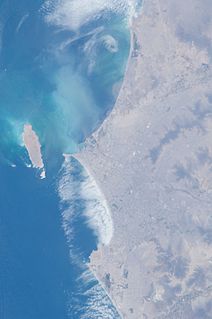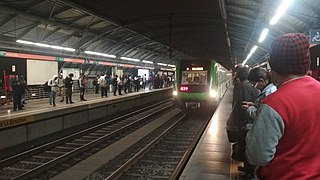
Lima is the capital and the largest city of Peru. It is located in the valleys of the Chillón, Rímac and Lurín rivers, in the central coastal part of the country, overlooking the Pacific Ocean. Together with the seaport of Callao, it forms a contiguous urban area known as the Lima Metropolitan Area. With a population of more than 9 million, Lima is the most populous metropolitan area of Peru and the seventh-largest metropolitan area in the Americas.

The Mexico City Metro, officially called Sistema de Transporte Colectivo, often shortened to STC, is a rapid transit system that serves the metropolitan area of Mexico City, including some municipalities in Mexico State. It is the second largest metro system in North America after the New York City Subway. In 2019, the system served 1.655 billion passengers, placing it as the tenth highest ridership in the world.

Line B of the Buenos Aires Underground runs 11.75 kilometres (7.30 mi) from Leandro N. Alem to Juan Manuel de Rosas in Villa Urquiza. Line B opened to the public on 17 October 1930.

The Lima Metro is a rapid transit system operated by Argentinian company Ferrovías and Peruvian company Graña y Montero, currently linking the district of Villa El Salvador in the south of Lima with San Juan de Lurigancho in the northeast of the capital of Peru.

Villa El Salvador (VES) is an urban, largely residential coastal district on the outskirts of Lima, Peru. It borders the district of Chorrillos on the east; the Pacific Ocean on the southwest; Lurín on the southeast; Villa María del Triunfo on the east and San Juan de Miraflores on the north.

The Lima metropolitan area, is an area formed by the conurbation of the Peruvian city-provinces of Lima and Callao. It is the largest of the metropolitan areas of Peru, the seventh largest in the Americas, the fourth largest in Latin America, and among the thirty largest in the world. The conurbation process started to be evident in the 1980s. The metropolitan area is composed of six subregions. These are Lima Norte, Lima Sur, Lima Este, Residential Lima, Central Lima, and Callao. Its estimated 2018 population is over 10.4 million according to the 2017 census.

The El Monte Busway is an 11-mile (18 km) shared-use express bus corridor (busway) and high occupancy toll lane running west along Interstate 10 from Interstate 605 and El Monte Station in El Monte, California, via busway stations at Cal State LA station and LA County+USC Medical Center station into Downtown Los Angeles and its terminus at Union Station.

Nuevos Ministerios is a major multimodal rail station on the Madrid Metro and the Cercanías Madrid commuter rail network. It is located beneath the Nuevos Ministerios government complex and the AZCA financial center at the intersection of the Paseo de la Castellana and Joaquín Costa and Raimundo Fernández Villaverde streets in Madrid, Spain. It services the districts of Tetuán, Chamberí, and Chamartín. The station serves Metro Line 6, Line 8, and Line 10, as well as Cercanías Lines C-1, C-2, C-3, C-4, C-7, C-8, and C-10. It is located in Metro fare zone A and Cercanías fare zone 0.

Mexico City Metro Line B is one of the twelve metro lines operating in Mexico City, Mexico. It has 21 stations and a total length of 23.722 km, 20.278 km service the line while the rest are used for maneuvers.

Faria Lima is a metro station on Line 4-Yellow of the São Paulo Metro operated by ViaQuatro. It is localized in Avenida Brigadeiro Faria Lima, between Rua Teodoro Sampaio and Rua Cardeal Arcoverde, in the district of Pinheiros. Had its civil construction concluded on February 2010. The prediction for the commercial operation was March 2010, but was delayed to 25 May 2010, day which line started operating between stations Faria Lima and Paulista. The delay was caused by the train tests. The station should also have a connection with future Line 20-Pink (Lapa–Afonsina).
Public transport in Lima is handled by buses, micros, taxicabs, and the so-called mototaxis. Micros are the most common means of public transportation in Lima and many other cities in Peru. There are also more than 100 km of cycle paths in the city.

Santiago Metro Line 1 is the oldest of the seven existing rapid transit lines that make up the Santiago Metro system. Being its busiest, it has a total of 27 stations along its 19.3 kilometre length, constructed almost entirely underground, and is located primarily along the axis formed by the Avenida Libertador General Bernardo O'Higgins, Providencia Avenue and Apoquindo Avenue.

Parque Industrial is a Lima Metro station on Line 1. The station is located between Villa El Salvador and Pumacahua. It was inaugurated on 28 April 1990 as part of the first section of the line between Villa El Salvador and Atocongo. However, commercial service only started on 18 January 2003, was suspended in July 2003 due to the lack of funds, and resumed only on Saturdays and Sundays on 17 January 2004. The full revenue service started on 3 January 2012, with trains running to Miguel Grau.

Pumacahua is a Lima Metro station on Line 1. The station is located between Parque Industrial and Villa María. It was inaugurated on 28 April 1990 as part of the first section of the line between Villa El Salvador and Atocongo. However, commercial service only started on 18 January 2003, was suspended in July 2003 due to the lack of funds, and resumed only on Saturdays and Sundays on 17 January 2004. The full revenue service started on 3 January 2012, with trains running to Miguel Grau.

Villa María is a Lima Metro station on Line 1. The station is located between Pumacahua and María Auxiliadora. It was inaugurated on 28 April 1990 as part of the first section of the line between Villa El Salvador and Atocongo. However, commercial service only started on 18 January 2003, was suspended in July 2003 due to the lack of funds, and resumed only on Saturdays and Sundays on 17 January 2004. The full revenue service started on 3 January 2012, with trains running to Miguel Grau.

María Auxiliadora is a Lima Metro station on Line 1. The station is located between Villa María and San Juan. It was inaugurated on 28 April 1990 as part of the first section of the line between Villa El Salvador and Atocongo. However, commercial service only started on 18 January 2003, was suspended in July 2003 due to the lack of funds, and resumed only on Saturdays and Sundays on 17 January 2004. The full revenue service started on 3 January 2012, with trains running to Miguel Grau.

San Juan is a Lima Metro station on Line 1. The station is located between María Auxiliadora and Atocongo. It was inaugurated on 28 April 1990 as part of the first section of the line between Villa El Salvador and Atocongo. However, commercial service only started on 18 January 2003, was suspended in July 2003 due to the lack of funds, and resumed only on Saturdays and Sundays on 17 January 2004. The full revenue service started on 3 January 2012, with trains running to Miguel Grau.

Atocongo is a Lima Metro station on Line 1. The station is located between San Juan and Jorge Chávez. It was inaugurated on 28 April 1990 as part of the first section of the line between Villa El Salvador and Atocongo. However, commercial service only started on 18 January 2003, was suspended in July 2003 due to the lack of funds, and resumed only on Saturdays and Sundays on 17 January 2004. The full revenue service started on 3 January 2012, with trains running to Miguel Grau.

Miguel Grau is a Lima Metro station on Line 1. The station is located between Gamarra and El Ángel. It was opened on 11 July 2011 as part of the extension of the line from Atocongo to Miguel Grau. The full revenue service started on 3 January 2012. On 25 July 2014 the line was extended to Bayóvar.

















